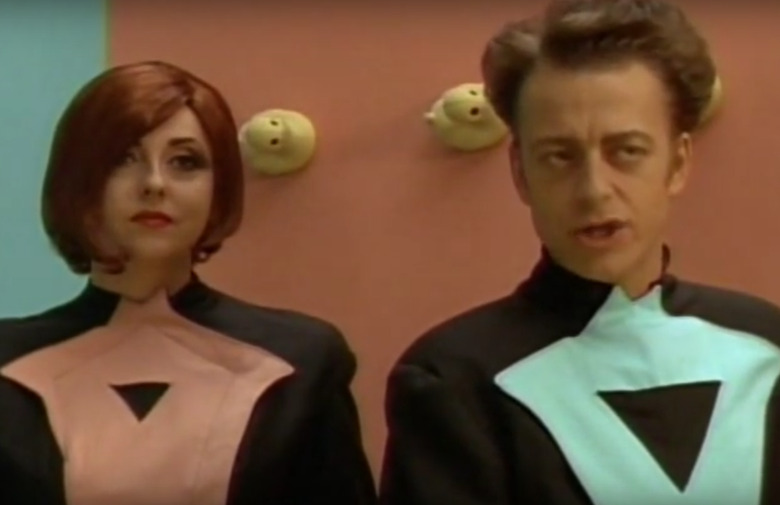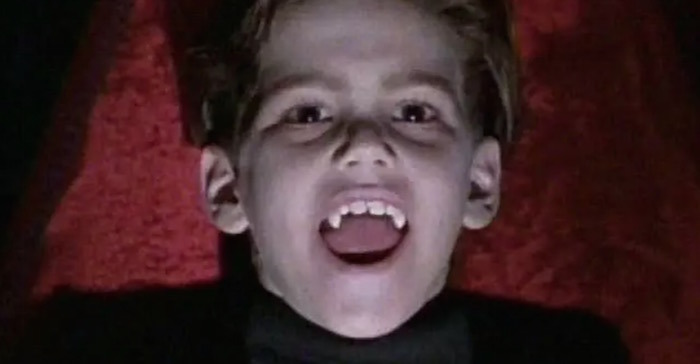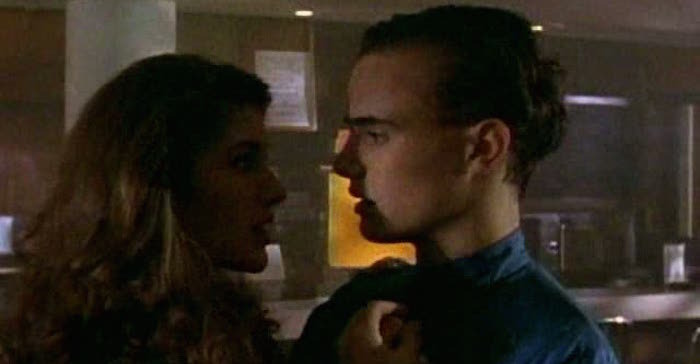Decades Later, Nothing Has Topped 'Are You Afraid Of The Dark' For Kid-Friendly Horror
(Welcome to Nostalgia Bomb, a series where we take a look back on beloved childhood favorites and discern whether or not they're actually any good. In this edition: revisiting the classic Nickelodeon series Are You Afraid of the Dark.)
It's been 18 years since Nickelodeon's Are You Afraid of the Dark went off the air, yet in that time the audience who grew up with the anthology series have never forgotten it. The weekly horror show followed a group of teens telling ghost stories around a campfire, telling us what to fear about life and adolescence.
But in the time since its debut in 1992 – its 26th anniversary just passed – Are You Afraid of the Dark has aged beautifully, telling stories that did more than just present ghosts and ghouls, but gave kids a look at the more amorphous frights they'd never thought of. Maybe this explains why its success has never been completely replicated since?
The Tale of the Other
Acting as a gateway for young audiences, identity factored heavily into several prominent Are You Afraid of the Dark episodes. This wasn't a surprise. A show aimed at kids and young adults couldn't ignore the changing mores that came with growing up and the conflicts that arise from questioning who you are, especially if you were a girl.
The season 2 episode "The Tale of the Thirteenth Floor" follows an adopted girl named Karen targeted by the mysterious denizens of a toy company on the 13th floor of her home. Like most horror stories, the "other" usually manifests as something monstrous – the little boy who is a vampire in "The Tale of the Nightly Neighbors" or any manner of creatures that popped up in the ensuing seasons – but here the others are literal aliens masquerading as bizarre, '80s-inspired baddies. Even more frightening: the other is Karen herself. It's discovered that Karen's otherness is literal on different levels; not only is she adopted, and thus the other in her family, but she's also an alien from another world and the toy company was her family attempting to bring her home.
"Tale of the Thirteenth Floor" takes the concept of otherness into a more timely direction. Karen is the literal embodiment of an alien, legality aside, who's made her home on planet Earth yet still feels different. The isolation adopted children feel transforms into something more grandiose. Karen is an outsider in her family, but she also comes off as a stranger to herself, and is literally an outsider to her planet. It is pretty laughable, though, in 2018 that the aliens are all white, with many jokes on Twitter being about how they're just kooky Europeans. Regardless, it resonates with a generation of children who might not have felt outside because they weren't popular, but also who felt slighted because they weren't born in the United States.
The Tale of the Cynical Storyteller
Several episodes of the series were kooky, cerebral, and downright cynical. Like its inspiration, The Twilight Zone, not every episode came with a happy ending. There was an element of fear that remained, reminding children that in life you can't fix some of the real terrors lurking in our world.
Midnight Society member Betty Ann was the resident cynic. Her first season episode, "The Tale of the Nightly Neighbors," features two kids who believe their new neighbors are vampires. After everything is supposedly disproven, it's revealed that the children's fears were true, and that while the adults aren't vampires, their "son" is. The moral of the story: adults don't always believe you, even when they should.
Her season 2 story, "The Tale of the Whispering Walls" sees two kids and their babysitter presumably defeat evil Master Raymond, whose house captures souls. But after the children are free to leave with their babysitter in tow, another car comes up behind them. They've escaped, but another lost soul is doomed to purgatory with Master Raymond. Betty Ann's stories said the joys of life were a temporary reprieve, and not everyone makes it out of the same situation unscathed.
Betty Ann's stories also told of the relationship between humanity and the natural landscape we continually destroy. Our shortsightedness would be our undoing. In season 3's "The Tale of Watcher's Woods" and season 5's "The Tale of the Chameleons," the natural world butts heads with mankind. "Watcher's Woods" is a happy interpretation, with two lost trail makers (one played by a pre-Firefly Jewel Staite) meeting the frightening watcher in the woods, hell-bent on protecting his Eden. It is only through the ingenuity of one of the girls, Sarah, that the two escape and the watcher is destroyed.
Yet this inversely presented in "The Tale of the Chameleons," wherein a teen girl realizes her best friend, Janis (played by Tia and Tamera Mowry) has been taken over by a chameleon. Chameleons, in this case, are presented as old-world spiritual creatures with more power than we give them credit for, opening the story up to an Invasion of the Body Snatchers-esque ending wherein the new Janis, and her "family" of chameleons are prepared to take over the world.
The Tale of Human Mortality
Wipe away the silliness, the occasionally decent creature effects, and the questionable acting, and you're left with what makes Are You Afraid of the Dark so unique: its acknowledgement and acceptance of death. The show never shied away from reminding children that their lives were ephemeral. Are You Afraid of the Dark didn't just alert kids to death in general, but presented the concept of an afterlife, to help cushion the blow of what is an existential crisis for all of us.
The popular season 3 episode "The Tale of the Dream Girl" is said to have inspired M. Night Shyamalan's The Sixth Sense with its story of a teenage boy who realizes he's actually dead, and the titular dream girl is trying to help him cross over. For the episode's protagonist, Johnny, the hardest thing to accept is that his life on Earth has ended, and that he'll have to leave his sister behind. There's no overt depiction of what awaits Johnny on the other side, but it's presented as positive. He's with "the girl of his dreams" and there's an implied notion that life for him continues in some form.
The series went further with deconstructing mortality in season 5's "The Tale of Station 109.1," where a death-obsessed boy named Chris accidentally stumbles upon a radio station for the dead. The episode has a Beetlejuice quality to it, presenting the processing of departed souls like the DMV, complete with Gilbert Gottfried's DJ Roy admitting that in life he worked there. Unlike "Tale of the Dream Girl," this episode presents versions of heaven and hell. A pleading man is carted through the doors by black-clad entities, implying that bad lives lead to bad afterlives. This comes through clearest after Chris sees another man crossover to the strains of a heavenly choir, bathed in golden light. Roy ends the tale by noting that if one leads a good life "it's the best thing going." For Chris, the idea of death sounds beneficial, until he actually dies. But the episode doesn't present a "carpe diem" message, so much as remind the audience that life is fleeting; how you live it is important, but death comes for us no matter what. So why rush towards it?
Nothing Quite Like It
There are certainly dated qualities to Are You Afraid of the Dark; race and ableism play into certain episodes in a way that don't ring positively today. But for a series aimed at children who would eventually grow up with all manner of new technologies, it's amazing to see how dark the series could be. In today's world, where kids can learn about the horrors of the world on their phones, it's not surprising that a network hasn't revived the series, and that's fine. Are You Afraid of the Dark taught us to be afraid of things we couldn't control, and accept that not every horror could be vanquished.



